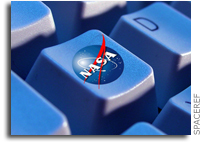NASA Claim About MSL Internet Effects Called Into Question – By NASA

 Keith’s 24 Sep 11:45 am note: According to a Tweet by @RPISciDean (Laurie Leshin): “From Jim Green at #CAPS: Traffic on the ENTIRE INTERNET increased by 30% during landing of @MarsCuriosity — wow! Go #MSL!” I have asked NASA PAO if they can confirm Jim Green’s claim – as relayed by Laurie Leshin.
Keith’s 24 Sep 11:45 am note: According to a Tweet by @RPISciDean (Laurie Leshin): “From Jim Green at #CAPS: Traffic on the ENTIRE INTERNET increased by 30% during landing of @MarsCuriosity — wow! Go #MSL!” I have asked NASA PAO if they can confirm Jim Green’s claim – as relayed by Laurie Leshin.
 Keith’s 24 Sep 6:30 pm update: No answer yet. This would be a rather remarkable accomplishment for NASA – rivaling the ~ 1 billion TV audience for the Apollo 11 landing. As such, one would think that the agency would be much more vocal about the impact of Curiosity’s landing on global Internet traffic – if this claim is true, that is.
Keith’s 24 Sep 6:30 pm update: No answer yet. This would be a rather remarkable accomplishment for NASA – rivaling the ~ 1 billion TV audience for the Apollo 11 landing. As such, one would think that the agency would be much more vocal about the impact of Curiosity’s landing on global Internet traffic – if this claim is true, that is.
 Keith’s 25 Sep 10:38 am update: According to NASA PAO: “NASA Public Affairs does not know where Jim Green got this information nor can we confirm it.” Now that NASA has officially cast doubt on the veracity of this claim, It would be nice if Jim Green would explain where he got this information – or admit that he made a mistake.
Keith’s 25 Sep 10:38 am update: According to NASA PAO: “NASA Public Affairs does not know where Jim Green got this information nor can we confirm it.” Now that NASA has officially cast doubt on the veracity of this claim, It would be nice if Jim Green would explain where he got this information – or admit that he made a mistake.
 Keith’s 25 Sep 7:00 pm update: According to NASA PAO, Jim Green was mistaken in referring to a “30% increase in traffic on the ENTIRE INTERNET”. Instead, there was a traffic spike on Akami around 2 am EDT on 6 Aug 2012 of “31% above normal” with regard to what traffic would normally be on certain portions of Akami (not the entire Internet). Akami handles a large portion of global Internet traffic at any given time. That said, NASA PAO says that during the Curiosity landing that thy doubled their previous high for peak webcast stream traffic. Indeed, in 48 hours they distributed more than 1 petabyte of data. But Jim Green’s claim that the entire Internet surged by 30% due to Curiosity-related traffic was simply inaccurate.
Keith’s 25 Sep 7:00 pm update: According to NASA PAO, Jim Green was mistaken in referring to a “30% increase in traffic on the ENTIRE INTERNET”. Instead, there was a traffic spike on Akami around 2 am EDT on 6 Aug 2012 of “31% above normal” with regard to what traffic would normally be on certain portions of Akami (not the entire Internet). Akami handles a large portion of global Internet traffic at any given time. That said, NASA PAO says that during the Curiosity landing that thy doubled their previous high for peak webcast stream traffic. Indeed, in 48 hours they distributed more than 1 petabyte of data. But Jim Green’s claim that the entire Internet surged by 30% due to Curiosity-related traffic was simply inaccurate.









I don’t know how they would know, but thinking about it I would have to say, yes, it’s possible and therefore within believable range. That landing was one heck of a of a challenge!
It’s a FUD unless there is metrics to back it up!
Netflix video streaming on the internet accounts for about 30 percent of the traffic volume.
It is not inconceivable that Curiosity’s landing attracted that same volume on the internet since, for some reason, it was not on any of the 2000 or so channels I get from my cable system.
Amen. I had NASA channel in college but have never seen it on any cable setup since then. * the cable companies. They can carry this channel for free and don’t!
Keith – the following information was passed along to me from the NASA Office of Communication a few weeks ago:
“final stats for http://www.NASA.gov for
the Curiosity landing” (not including traffic at mars.jpl.nasa.gov): 1.2
million webcast streams at peak — “more than double the previous record” – and 36.4
million webcast streams over the course of the 48-hour landing event. This
number represents more than a third of all nasa.gov webcast streams since NASA
began streaming in 2004. “Roughly 3.8 million webcast streams went to mobile
devices.” For the landing event, nasa.gov counted about 20 times the page views
it records in a typical 48-hour period, and 14.7 million visitor sessions. The
MSL landing was “easily the largest live event we’ve ever had.”I’ve cited these stats in an op-ed to be published in Space News next month.Linda Billings
But that is not “The ENTIRE INTERNET”. Jim Green needs to do a little fact checking.